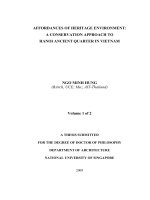A topical approach to life span development, 6e chapter 1
Bạn đang xem bản rút gọn của tài liệu. Xem và tải ngay bản đầy đủ của tài liệu tại đây (60.05 KB, 33 trang )
Live Span Perspective
Chapter 1
Development
•
The pattern of change from conception to end of life.
•
Includes growth
•
Includes decline brought on by aging
Development is:
•
Lifelong - No age period dominates development
•
Multidimensional - Body, mind, emotions, and relationships are changing and
affecting each other
•
Biological Dimensions
•
Cognitive Dimensions
•
Socioemotional Dimensions
Development is:
•
Multidirectional - These dimensions or components of these dimension expand
and others shrink
•
•
Ex: Language Skills, Relationships, Wisdom
Plastic - These dimensions have the capacity for change
•
Ex: Cognition can improve for the elderly
Development is:
•
Multidisciplinary - various interested parties
•
Psychologists
•
Sociologists
•
Anthropologists
•
Neuroscientists
•
Medical researchers
Development is:
•
Contextual - situational
•
Ex: Families, schools, churches, countries, etc.
•
Influenced by history, economics, social and cultural factors
Development is:
•
3 Types of Contextual Influences
•
Normative age-graded - Similar for individuals in a particular age groups
•
•
Normative history-graded - generational
•
•
Ex: Puberty and menopause
Ex: Civil Rights Movement, Great Depression, Wars
No normative life events - Unusual occurrences that impact lives
•
Death of a child, winning a lottery
Development is:
•
As we age it involves:
•
Growth
•
Maintenance
•
Regulation of Loss
Development is:
•
A Co-Construction of Biology, Culture, and the Individual factors working together.
•
Each shapes each other.
Development Process
•
Biological
•
•
Cognitive
•
•
Changes in physical nature
Changes in thought, intelligence and language
Socioemotional
•
Relational, emotional and personality
Periods of Development
•
A time frame in a person's life that is characterized by certain features.
•
8 period sequence
•
Prenatal- Conception to birth
•
Infancy- birth to 24 months
•
Early childhood- 3-5 years
•
Middle and late childhood-6 to 10/11 years
•
Adolescence - 10-12 to 18-21 years
•
Early adulthood - 20s to 30s
•
Middle adulthood-40s to 50s
•
Late adulthood- 60s, 70s, to death
Conceptions of Age
•
Chronological Age
•
•
Biological Age
•
•
Health related age
Psychological age
•
•
Years since birth
Adaptive capacities compared to others with same chronological age
Social age
•
Connectedness with others
All are Important
The Nature of Development
•
Nature and Nurture
•
Nature- biological inheritance
•
Nurture-environmental experiences
The Nature of Development
•
Stability and Change
•
Stability- we become older renditions of early experiences
•
Change- we become someone different
The Nature of Development
•
Continuity and discontinuity
•
Continuity - development involves gradual cumulative changes
•
Discontinuity - development involves distinct stages
Scientific Method
•
Four step process
1.
Conceptualize a process of problem to be studied
2.
Collect research information (data)
3.
Analyze the data
4.
Draw conclusions
In Formulating a Program (step 1)
•
Researchers draw on a theories and develop hypotheses.
•
Theory-An interrelated, coherent set of ideas that helps to explain
phenomena and facilitate predictions
•
Hypotheses- Specific assumptions and predictions that can be tested to
determine their accuracy
Theoretical Orientations to Development
•
Psychoanalytic Theories
•
Cognitive Theories
•
Behavioral and Social Cognitive Theories
•
Ethnological Theory
•
Ecological Theory
•
An Eclectic Theoretical Orientation
Psychoanalytic Orientations to
Development
•
Psychoanalytic Theories (Freud, Erikson)
•
Development is primarily unconscious
•
Emotive
•
Deep inner workings of the mind
•
Symbolic meanings of behavior
•
Early experienced with parents shape development
Psychoanalytic Orientations to
Development
•
Freud's Psychosexual Stages - "if the need for pleasure at any stage is either under gratified
or over gratified, an individual may become fixated, at that stage of development.
•
Oral - pleasure is centered on the mouth
•
Anal- pleasure focuses on the anus
•
Phallic- pleasure focuses on the genitals
•
Latency-develops social and intellectual skills
•
Genital- sexual pleasure
Psychoanalytic Orientations to
Development
•
Erikson's 8 Psychosocial stages of human development
•
Each stage consists of a unique developmental task that confronts
individuals with a crisis (turning point) that must be resolved.
•
The more successful an individual resolves each crisis, the healthier
development will be.
•
Early and later experiences.
Psychoanalytic Orientations to
Development
•
Erikson's 8 Psychosocial stages of human development
•
Trust versus mistrust
•
Autonomy versus shame and doubt
•
Initiative versus guilt
•
Industry versus inferiority
•
Identity versus identity confusion
•
Intimacy versus isolation
•
Generative try versus stagnation
•
Integrity versus dispair
Cognitive Orientations to Development
•
Cognitive Theories (Importance of conscious thoughts)
•
Piaget's Cognitive Developmental Theory
•
Vygotsky's Sociocultural Cognitive Theory
•
Information-processing Theory
Cognitive Orientations to Development
•
Piaget's 4 Stages of a Child's cognitive development (understanding the world)
•
Sensorimotor stage -coordinating sensory experiences with physical actions. (Birth to 2
years)
•
Pre operational stage- words and images reflecting symbolic thinking (2-7 years)
•
Concrete operational stage- perform operations, reason logically (7 to 11)
•
Formal operational stage- reasoning is abstract, idealistic and logical (11-15)









